AM Quality Management Matures
The 2023 Formnext show was a hotbed of new announcements, many leveraging AI to ensure consistent print quality and traceability for production-scale applications.
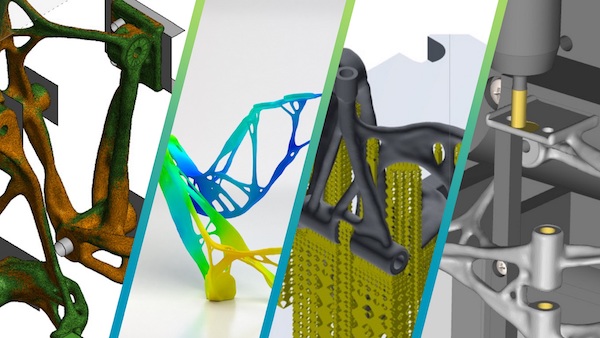
HxGN Additive Manufacturing Suite integrates four software tools to drive operational excellence in machine shops and 3D printing service bureaus. Image courtesy of Hexagon.
Latest News
February 6, 2024
If the announcements at last year’s Formnext show are any barometer, the additive manufacturing (AM) industry is entering a new stage of maturity, bolstered by a wave of offerings designed to operationalize and industrialize the technology for production use cases at scale.
With artificial intelligence (AI) and machine learning (ML) underpinning many of the announcements, vendors rolled out software tools and platforms designed to address quality management, printer performance monitoring and workflow challenges that have been long-standing hurdles to AM gaining traction for production-scale applications. Industry watchers are projecting robust growth for the AM market—a new study by SNS Insider is estimating a compound annual growth rate of 30.6% during the forecast period from 2023 to 2030, ultimately hitting $74.7 billion in sales by the end of the decade. The same report pegged the AM market at $16.7 billion in 2022.
Despite the bullish growth projections and the rapid evolution of AM technologies and materials, it remains too difficult to optimize build strategies to ensure consistent, high-quality output of parts. In particular, repeatability is a struggle—not just on a single AM system, but ensuring parts can be reproduced in a repeatable and consistent fashion across multiple systems, housed in the same factory, spread across different locations and even across multiple geographies, each with varying environmental factors.
“Advances are there, but they’re usually localized to specific types of processes, to specific materials, and to specific printer vendors,” says Tommaso Tamarozzi, product director, additive manufacturing, inspection & simulation, at Oqton, a maker of AI-powered manufacturing software solutions. “There has been a lack of a general solution that can solve a wide range of problems.”
AI/ML Take Center Stage
With the industry hungry for market expansion, vendors are stepping in with solutions to address the quality challenges and to streamline workflows to make 3D printing more accessible for a wider audience. 3D printer manufacturers are increasing the number of sensors and cameras in their offerings, using those instruments to generate and collect data streams that, through smart use of AI and machine learning, can be mined for insights to aid in print quality management and printer performance.
While AI/ML isn’t ubiquitous across the latest round of announcements, the technologies are playing a more prominent role. They will continue to do so to aid in the complex decision making that leads to better parts output, particularly as manufacturers move from one-off prototyping and small-batch output to leveraging AM for large-scale production.
Consider the quality engineer working with a selective laser melting (SLM) metal 3D printer. With one or two lasers in play, a human can manage and correlate sensor data, simulation data and geometry analysis to figure out the optimal process parameters that will guarantee part integrity and 3D printing success. But as complexity rises with multilaser 3D printing systems and ultimately, more SLM printers in play, it becomes impossible for the average human to interpret data and make decisions in real time.
“You would need da Vinci-level prowess to coordinate a printer with 12 lasers,” says Harshil Goel, CEO at Dyndrite, which makes a graphics processing unit (GPU)-accelerated computation engine to power next-generation digital manufacturing hardware and software. “There are so many possible decisions to make and so many possible permutations. AI acts as a co-pilot to help customers make decisions as quickly as possible.”
AI is also essential to leveraging sensor feedback in real time to power closed-loop control and in situ monitoring. In these scenarios, still in the early stages of development and evolving, AM printer parameters are automatically recalibrated in real time to ensure print quality and part integrity and to stave off anomalies and part deformation. Even at that level of engagement, Goel cautions not to think of AI as outside the parameters of work that has always been done; AI just makes it possible to happen at scale.
“AI is a weird catch-all term when in actuality it’s what engineers have been doing all along—applying linear algebra and numerical analysis to their decision making,” Goel explains. “It’s all about managing risk.”
In its latest announcement, Dyndrite announced that Dyndrite LPBF Pro, a new application for professionals using laser powder bed fusion 3D printers, is now available as part of its VIP Onboarding program, which provides hands-on consulting and guidance for early adopters of its products. The software gives materials, quality, process and applications engineers scalable, multithreaded CPU and GPU-powered performance to solve geometry and compute challenges, refine print preparation processes and experiment and iterate with materials.
The software, which interfaces directly with various metal 3D printers, including Aconity3D, Renishaw and SLM, eliminates the tedious and error-prone process of manual build prep and ultimately enables lights-out metal printing.
“As machines get bigger and more complicated, the data requirements skyrocket,” Goel says. “Our software leverages GPUs, CPUs and as many computers on the network as possible to push throughput.”
Nexa3D, the maker of the XiP Pro Industrial 3D printer, is also leaning into AI capabilities to enhance print quality and printer performance and to automate the entire end-to-end process, from file preparation to post-processing. Nexa AI collects data with every print, using it to continuously tweak and optimize print parameters to prevent instances such as failed prints, suboptimal support structures and inefficient post-processing. The AI-enabled print intelligence is amplified with each print, enabling users to benefit from streamlined and automated workflows, remote monitoring and print management, as well as real-time error detection, intervention and remediation.
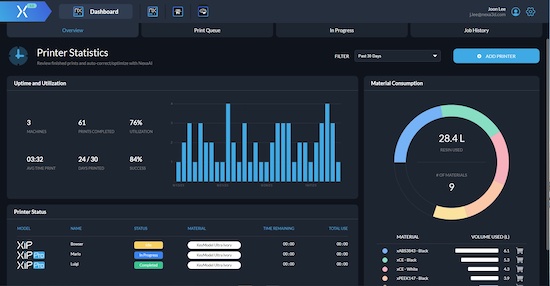
AI-enabled NexaX software enables remote print management, real-time error detection, intervention and remediation. Image courtesy of Nexa3D.
“Nexa AI not only alerts users to what went wrong, it learns from failures or deviations from normality about the physics of a print and refines the processes for next time,” says Izhar Medalsy, Nexa3D’s chief technology officer. “It’s the combination of real-time data harvesting and monitoring of the digital twin, coupled with predictive capabilities, that delivers an additional edge.”
Repeatability and Consistency
With its new Build Quality platform, Oqton is aiming for a general solution that advances quality before, during and after the AM build to maximize processes and outcomes. The product suite modules, which work independently or together, include:
Oqton 3DXpert Build Simulation, used to predict printability issues and prevent design anomalies before the first print starts;
MOS Building monitoring, which securely monitors, controls and alerts the AM print process in real time. This capability, developed with Oqton partner Baker Hughes, employs AI models to detect potential defects during printing, allowing users to track and trace each print layer and take corrective action; and
3Dxpert Build Inspection comes in after parts are completed, analyzing final output to ensure it aligns with what was expected during the build process and build simulation.
While using each module helps detect and prevent build problems, leveraging all three as part of an integrated AM quality management suite creates a more holistic workflow.
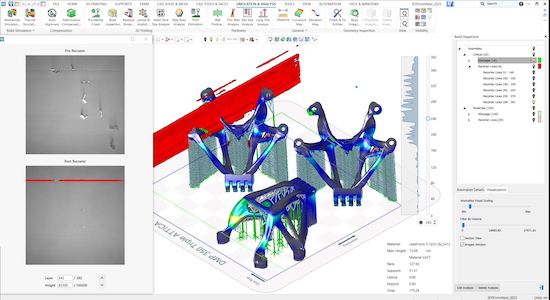
Oqton Build Quality helps trace and inspect quality metrics of AM parts and evaluate build performance. Image courtesy of Oqton.
“Each of the modules detect different problems and solve different problems and if you have all, you capture more of them,” says Oqton’s Tamarozzi. “An end-to-end workflow that overlays different types of results captured at different stages provides a lot of information … and shows customers that they can maintain a certain part quality printing over multiple sites.”
For its part, Hexagon is trying to bring repeatability to the shop floor with a new suite of tools that are machine independent and CAD agnostic. The HxGN Additive Manufacturing Suite works with existing CAD software, metal powder bed fusion (PBF) printers, and computer numerically controlled (CNC) machines, helping shop floor personnel automate time-consuming processes and optimize production virtually before any physical build takes place.
The platform includes: Designer, a CAD manufacturing solution used to reverse engineer or design parts; AM STUDIO, for build preparation for any metal PBF AM printer, including slicing and hatching capabilities; Simufact Additive, for simulating print jobs and optimizing print strategies and build orientation; and ESPIRIT EDGE, which uses AI and digital twin technology to ensure CNC machining and post-processing is precise. The new suite also allows manufacturing personnel to collaborate and share best practices through Nexus, Hexagon’s open digital reality platform.
“What’s slowing down the industrialization of AM is the quality of what’s being made and productivity,” says Mathieu Perennou, global director of additive manufacturing solutions at Hexagon’s Manufacturing Intelligence division. “Combining all the different steps into one solution solves the problem of having to jump from one product to the next and delivers all the tools under one common interface.”
To take quality and process control to the next level, Materialise rolled out CO-AM Quality and Process Control (QPC), a solution that enables AM users to track, monitor, analyze and correlate all data critical to part quality. The software interconnects AM data sources, including 3D models, raw materials, process parameters, in-situ process monitoring, post processing and quality inspection, at the different stages of product development. The idea is to provide a holistic view of the end-to-end process and resulting interrelationships. The QPC system is also part of Materialise’s broader CO-AM Software platform.
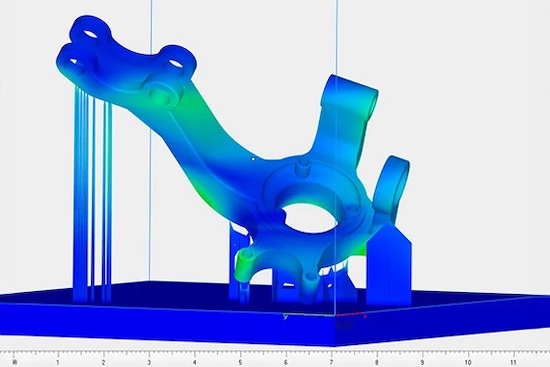
Materialise is partnering with Ansys to integrate its simulation technology into its software platform to support seamless workflows. Image courtesy of Materialise.
The first module in QPC was Layer Analysis, announced earlier this year, which helps users analyze and correlate layer data from the 3D printing process. This module has been further developed to include more in-situ process monitoring data sources along with the ability to correlate results with CT scans. A new addition is QPC Process Lab, a module designed to foster collaboration among teams to centralize production data in a structured way so it can be easily accessed.
In other news, Materialise announced a partnership with Ansys to make Ansys simulation data more accessible for users of Materialise Magics, its data and build preparation software. The integration is aimed at creating a seamless workflow, including making it easier to apply simulation results to the build preparation process to ensure print success and part quality. The partners plan to explore further opportunities for simulation in the AM process.
Beth Stackpole is a contributing editor to DE. You can reach her at [email protected].
More Dyndrite Coverage
More Hexagon MSC Software Coverage
More Materialise Coverage
More Nexa3D Coverage
More Oqton Coverage
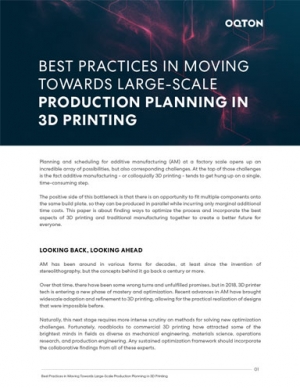
Subscribe to our FREE magazine, FREE email newsletters or both!
Latest News
About the Author
Beth Stackpole is a contributing editor to Digital Engineering. Send e-mail about this article to [email protected].
Follow DE






